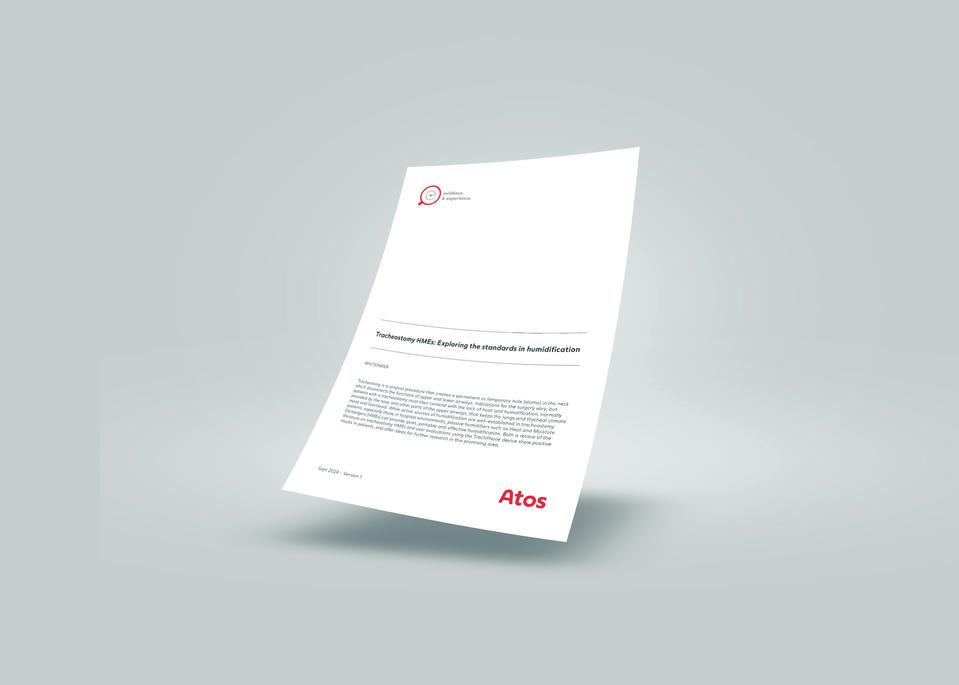Heat and Moisture Exchangers (HMEs) for Patients with a Tracheostomy
In patients with a tracheostomy, the upper airway is bypassed, preventing inhaled air from being naturally warmed, humidified, and filtered by the nose and nasopharynx. This can negatively impact pulmonary health resulting in excessive mucus production and coughing.1-4 Tracheostomy heat and moisture exchangers (HMEs) are a portable and effective option to restore heat and humidification to the airways.
Discover the features and benefits of:
- TrachPhone heat and moisture exchangers (HMEs)
- Freevent XtraCare heat and moisture exchanger + filter (HMEF)

Improving Pulmonary Health with HMEs
An HME is a device that attaches directly to the tracheostomy tube to condition the inspired air. During exhalation, the HME captures heat and moisture from the exhaled breath. During inhalation, the stored heat and moisture are released to condition the inspired air. Using HMEs has been shown to restore humidity and warmth which results in decreased viscosity of mucus, less coughing, and improvements in respiratory functions. 5-7
TrachPhone – The Multifunctional HME
TrachPhone is a lightweight HME designed for spontaneously breathing patients. It provides effective humidification and includes additional features for suctioning, speech, and supplemental oxygen.
TrachPhone features:
Oxygen port

Suction port

Speech valve

Additionally, TrachPhone HME contains hygroscopic foam. Studies have shown that foam saturated with a hygroscopic compound, such as calcium chloride have increased ability to absorb and release moisture resulting in better performance of the HME.8,9
Additional TrachPhone resources:
Freevent XtraCare – An HME plus filter for extra protection (HMEF)
Freevent XtraCare is a heat and moisture exchanger with a highly effective electrostatic filter (HMEF). It contains a hygroscopic foam core which traps moisture and warmth from the patient’s exhaled breath and then releases this heat and moisture during inhalation. Additionally, the filter provides protection against airborne particles, including viruses and bacteria, with a filtration efficiency of more than 98%.10,11* It is intended for spontaneously breathing patients with a tracheostomy tube.
If supplement oxygen is needed, Freevent XtraCare can be combined with Freevent O2 adapter.
* Please note: Since pathogens can enter and leave the human body in other ways (such as the mouth, nose, and eyes), Freevent XtraCare can never guarantee complete protection.

Additional resources:
Exploring the Standards in Humidification
Patients with a tracheostomy face challenges in maintaining optimal lung and tracheal climate due to the absence of natural heat and humidification from the upper airways. While active humidification is common in hospital settings, passive humidifiers like Heat and Moisture Exchangers (HMEs) offer a portable and effective alternative. This Whitepaper reviews research on HMEs and user feedback on the TrachPhone device, highlighting positive outcomes and future research directions.

On-demand webinars
For more information, check the Atos Learning Institute Events for upcoming and on-demand webinars on Tracheostomy topics.
Explore product solutions:
References:
1. De Leyn P, Bedert L, Delcroix M, Depuydt P, Lauwers G, Sokolov Y, et al. Tracheotomy: clinical review and guidelines. Eur J Cardiothorac Surg. 2007;32(3):412-21.
2. Hilgers FJ, Ackerstaff AH, Aaronson NK, Schouwenburg PF, Van ZN. Physical and psychosocial consequences of total laryngectomy. Clin Otolaryngol Allied Sci. 1990;15(5):421-9.
3. Lorenz KJ, Groll K, Ackerstaff AH, Hilgers FJ, Maier H. Hands-free speech after surgical voice rehabilitation with a Provox voice prosthesis: experience with the Provox FreeHands HME tracheostoma valve system. Eur Arch Otorhinolaryngol. 2007;264(2):151-7.
4. Mehta AK, Chamyal PC. Tracheostomy Complications and Their Management. Med J Armed Forces India. 1999;55(3):197-200.
5. Van den Boer C, Lansaat L, Muller SH, van den Brekel MW, Hilgers FJ. Comparative ex vivo study on humidifying function of three speaking valves with integrated heat and moisture exchanger for tracheotomised patients. Clin Otolaryngol. 2015;40(6):616-21. https://doi.org/10.1111/coa.12426.
6. De Kleijn BJ, van As-Brooks CJ, Wedman J, van der Laan BF. Clinical feasibility study of protrach dualcare a new speaking valve with heat and moisture exchanger for tracheotomized patients. Laryngoscope Investig Otolaryngol. 2017;2(6):453-8. https://doi.org/10.1002/lio2.124.
7. Wong CY, Shakir AA, Farboud A, Whittet HB. Active versus passive humidification for self-ventilating tracheostomy and laryngectomy patients: a systematic review of the literature. Clin Otolaryngol. 2016;41(6):646-51. https://doi.org/10.1111/coa.12577.
8. Mebius C. A comparative evaluation of disposable humidifiers. Acta Anaesthesiol Scand. 1983;27(5):403-9.
9. Van den Boer C, Vas Nunes JH, Muller SH, van den Brekel MW, Hilgers FJ. Water Uptake Performance of Hygroscopic Heat and Moisture Exchangers after 24-Hour Tracheostoma Application. Otolaryngol Head Neck Surg. 2014;150(6):999-1004.
10. Nelson Laboratories. Bacterial Filtration Efficiency (BFE) GLP Report. Salt Lake City, USA. Available on request from Atos Medical. www.atosmedical.com. 2014.
11. Nelson Laboratories. Viral Filtration Efficiency (VFE) GLP Report. Salt Lake City, USA. Available on request from Atos Medical. www.atosmedical.com. 2014.


